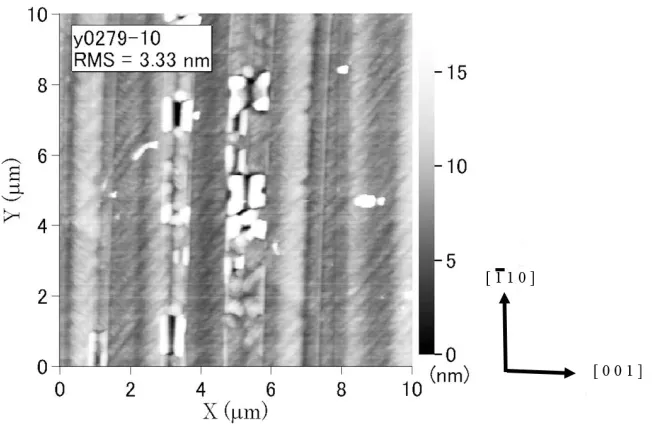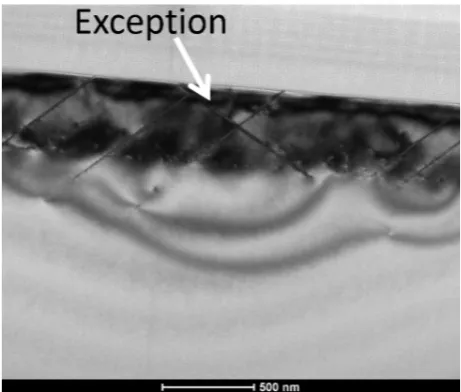ISSN Online: 2327-6053 ISSN Print: 2327-6045
DOI: 10.4236/msce.2018.61004 Jan. 4, 2018 25 Journal of Materials Science and Chemical Engineering
Surface Roughness of SiGe/Si(110) Formed by
Stress-Induced Twins and the Solution to
Produce Smooth Surface
Junji Yamanaka
1, Mai Shirakura
1, Chiaya Yamamoto
1,2, Naoto Utsuyama
3, Kei Sato
3,
Takane Yamada
3, Kosuke O. Hara
3, Keisuke Arimoto
3, Kiyokazu Nakagawa
31Center for Instrumental Analysis, University of Yamanashi, Kofu, Japan
2Center for Creative Technology, University of Yamanashi, Kofu, Japan
3Center for Crystal Science and Technology, University of Yamanashi, Kofu, Japan
Abstract
Lattice-strained Si thin films grown onto SiGe(110)/Si(110) are attracting be-cause of their potential to realize high-speed transistors. In this study we ob-serve surface morphology of Si/SiGe/Si(110) using scanning electron micro-scopy and we also observe microstructure of the identical position using cross-sectional transmission electron microscopy. These results reveal that crossing of stress-induced twins causes remarkable surface roughness. We propose using vicinal substrate to avoid this phenomenon and our successive experimental results are shown in this paper.
Keywords
Strained Si, SiGe(110), Stress-Induced Twin, Transmission Electron Microscopy
1. Introduction
In order to produce a high-speed field-effect-transistor (FET), strain control of semiconductor thin films are very important because elastically strained semi-conductors sometimes show very high carrier mobility. Therefore many research groups in the world carried out both theoretical and experimental works on this view-point. Especially strained-Si grown onto SiGe(110) Si(110) is considered to be a promising material for complementary metal oxide semiconductor (CMOS) cir-cuits [1]-[14]. Recently K. Arimoto and other members of our group have been studied the crystal-growth mechanism of lattice-strained-Si/lattice-relaxed-SiGe/
How to cite this paper: Yamanaka, J., Shirakura, M., Yamamoto, C., Utsuyama, N., Sato, K., Yamada, T., Hara, K.O., Ari-moto, K. and Nakagawa, K. (2018) Surface Roughness of SiGe/Si(110) Formed by Stress-Induced Twins and the Solution to Produce Smooth Surface. Journal of Mate-rials Science and Chemical Engineering, 6, 25-31.
https://doi.org/10.4236/msce.2018.61004
DOI: 10.4236/msce.2018.61004 26 Journal of Materials Science and Chemical Engineering Si(110) hetero-structure [12] [13] [14]. These studies showed us that stress-induced twins were introduced during the SiGe growth and they had an important role to relax the SiGe buffer layers and to form strained Si layers. However, some spe-cimens showed remarkable surface roughness. We must avoid surface roughen-ing to produce a high-speed FET because of the well-known negative effect of the interface scattering.
The purpose of this study is identifying the origin of this remarkable surface roughness observed on Si/SiGe(110)/Si(110). We also challenge to produce a Si/SiGe/Si(110) with flat surface.
2. Experimental Procedure
Commercially available Si(110) wafers were used as substrates after chemical and thermal cleaning. Then we deposited thin films onto the Si(110) using sol-id-source-MBE. At first compositionally step-graded SiGe layers were deposited. Then uniform SiGe layers, and after that, the top Si layers were deposited. The substrates’ temperature was 600˚C. The total thickness of the SiGe buffer layers were 400 - 800 nm. The thickness of the top Si layer was 20 nm. The growth rate of the film was about 0.1 - 2 A/sec. Surface morphology of the specimens was observed by atomic force microscope (AFM) and scanning electron microscope (SEM). After these observations, we coated the specimens with protection layersto avoid ion-bombardment of focused ion beam (FIB). The 1st protection layer was permanent marker’s ink. The 2nd one was a sputtered Pt-Pd. The 3rd and final one was a W layer. Then we picked up a part of the specimens and thinned them using FIB. After that we observed the micro-structure of the spe-cimens using transmission electron microscopes (TEM). After the FIB and the TEM, we chemically removed the protection layers from some of the specimens and observed surface morphology again using SEM to make clear where the cross-sectional TEM data were taken from. (We used the ink, which can be solved by using acetone, as the 1st protection layer for this purpose.)
3. Results and Discussion
First, surface morphology of the specimens was observed by AFM. A typical AFM image is shown in Figure 1. We also took scanning electron micrograph and its typical result is shown in Figure 2. Straight lines along [110] direction are seen in both images. It has been already known through our previous works that these line are the result of stress induced twins. The important point of these images shown in Figure 1 and Figure 2 is thick remarkable roughness which are also parallel to [110] direction. The widths of the thick roughness are submicron or micron orders. These roughness must effect negatively when we produce a FET, therefore it is very important to know the origin of them and to reduce them.
DOI: 10.4236/msce.2018.61004 27 Journal of Materials Science and Chemical Engineering Figure 1. A typical AFM image of the specimen surface.
Figure 2. A typical SEM image of the specimen surface.
Figure 3. A wide view SEM image of the specimen surface. Red rectangle area was used for cross-sectional TEM observation (see Figure 4).
[image:3.595.254.494.468.607.2]DOI: 10.4236/msce.2018.61004 28 Journal of Materials Science and Chemical Engineering the plan-view SEM image (compare Figure 3 and Figure 4). The plan-view SEM observation and the cross-sectional TEM observation of the identical position reveals that the origin of the thick roughing band is the crossing of the stress-induced twins.
[image:4.595.208.538.251.294.2]Figure 5 shows a set of precise TEM observations of the area where the stress-induced twins are crossing each other. (The observed are of the Figure 5 is not shown in Figure 4, but it is close to the area shown in Figure 4.) The dark field TEM images (DFI) in Figure 5 show that the crystallographic orientations of the twins are same even after the crossing. However, more important infor-mation is as follows: The DFI in Figure 5 show that the original stress-induced twins are quit thin (less than 20 nm thick), but after the crossing the twins show
Figure 4. A wide range cross-sectional TEM image. The TEM specimen for this observa-tion was picked up from the red rectangle area shown in Figure 3.
[image:4.595.208.539.339.668.2]DOI: 10.4236/msce.2018.61004 29 Journal of Materials Science and Chemical Engineering thicker (about 100 nm) widths than the original ones. The specimen surface of the two thick twins and the region sandwiched by the twins do not show flat morphology.
Figure 6 shows a TEM bright field image, narrow area (~200 nm) selected diffraction patterns (SADPs), and high-resolution transmission electron micro-graphs (HREMs) taken from the same area of Figure 5. The SADPs in Figure 6 approve that the crystallographic orientations of the twins are same even after the crossing as mentioned before using the results of Figure 5. The HREM shown in Figure 6(F) shows that the thick twin just under the specimen-surface was made up of many thin twins which have only several {111} planes, although it is not clear whether or not this fact is related to the surface roughening.
The HREM around the crossing point of the stress-induced twins, which is shown in Figure 6(E), was taken in order to analyze what happened at the point. This HREM shows the atomic-layer stacking is always as same as the original crystal or twin crystals. The scientific reason of this experimental fact is not known yet and further experiments and discussions are needed.
[image:5.595.210.537.339.655.2]Now it is revealed that the crossing of the stress-induced twins cause remarkable
DOI: 10.4236/msce.2018.61004 30 Journal of Materials Science and Chemical Engineering Figure 7. A bright field TEM of the specimen deposited onto a
vicinal substrate.
thick rough band on the specimen surface. There still exists a room for scientific discussion to understand the origin of this phenomena, however, it is clear that we can produce a smoother surface if we can reduce the crossing of the twins. K. Arimoto and other members of our group have already had the technique to re-duce the crossing of the stress-inre-duced twins through our previous works for other purpose [10] [11] [12] [13] [14]. The stress-induced twins were formed along one kind of {111} plane when we used vicinal substrate because the stresses onto the (111) and on the (11 1) are different [12]. In this study, we can
apply this technique onto our new specimens. Figure 7 is a bright field TEM image of the specimen deposited onto a vicinal substrate. It is clearly seen that the density of the crossing twins are drastically reduced because almost all twin are parallel, although there still exist very small amount of twins which have a different direction.
4. Summary
We observed the surface morphology of Si/SiGe/Si(110) mainly using scanning electron microscopy and we also observed microstructure of the specimens us-ing cross-sectional transmission electron microscopy. Through these precise ob-servations, the following results were shown:
1) The plan-view SEM observation and the cross-sectional TEM observation of the identical position reveal that the origin of the thick roughing band is the crossing of the stress-induced twins.
2) The twins keep their crystallographic orientations even after crossing each other. On the other hand, the widths of the twins drastically increase after the crossing.
DOI: 10.4236/msce.2018.61004 31 Journal of Materials Science and Chemical Engineering
References
[1] Mizuno, T., Sugiyama, N., Tezuka, T., Moriyama, Y., Nakaharai, S. and Takagi, S. (2005) [110]-Surface Strained-SOI CMOS Devices. IEEE Transactions on Electron Devices, 52, 367-374. https://doi.org/10.1109/TED.2005.843894
[2] Teramoto, A., et al. (2007) Very High Carrier Mobility for High-Performance CMOS on a Si(110) Surface. IEEE Transactions on Electron Devices, 54, 1438-1445. https://doi.org/10.1109/TED.2007.896372
[3] Kuan, T.S. and Iyer, S.S. (1991) Strain Relaxation and Ordering in SiGe Layers Grown on (100), (111), and (110) Si Surfaces by Molecular-Beam Epitaxy. Appl. Phys. Lett., 59, 2242. https://doi.org/10.1063/1.106083
[4] Hartmann, J.M., Burdin, M., Rolland, G. and Billon, T. (2006) Growth Kinetics of Si and SiGe on Si(1 0 0), Si(1 1 0) and Si(1 1 1) Surfaces. J. Cryst. Growth, 294, 288-295. https://doi.org/10.1016/j.jcrysgro.2006.06.043
[5] Destefanis, V., Hartmann, J.M., Abbadie, A., Papon, A.M. and Billon, T. (2009) Growth and Structural Properties of SiGe Virtual Substrates on Si(1 0 0), (1 1 0) and (1 1 1). J. Cryst. Growth, 311, 1070-1079.
https://doi.org/10.1016/j.jcrysgro.2008.12.034
[6] Destefanis, V., Rouchon, D., Hartmann, J.M., Crisci, A., Papon, A.M., Baud, L. and Mermoux, M. (2009) Structural Properties of Tensily Strained Si Layers Grown on SiGe(100), (110), and (111) Virtual Substrates. J. Appl. Phys., 106 043508.
https://doi.org/10.1063/1.3187925
[7] Arimoto, K., et al. (2009) Structural and Transport Properties of Strained SiGe Grown on V-Groove Patterned Si(110) Substrates. J. Cryst. Growth, 311, 814-818. https://doi.org/10.1016/j.jcrysgro.2008.09.062
[8] Arimoto, K., et al. (2017) Hole Mobility in Strained Si/SiGe/Vicinal Si(110) Grown by Gas Source MBE. J. Cryst. Growth, 468, 625-629.
https://doi.org/10.1016/j.jcrysgro.2016.12.076
[9] Kato, M., Arimoto, K., Yamanaka, J., Nakagawa, K. and Sawano, K. (Available On-line 24 May 2017) Fabrication of High-Quality Strain Relaxed SiGe (1 1 0) Films by Controlling Defects via Ion Implantation. J. Cryst. Growth, in Press.
[10]Arimoto, K., et al. (2006) Determination of Lattice Parameters of SiGe/Si(110) He-terostructures. Thin Solid Films, 508, 132-135.
https://doi.org/10.1016/j.tsf.2005.08.412
[11]Arimoto, K., et al. (2007) Growth Temperature Dependence of Lattice Structures of SiGe/Graded Buffer Structures Grown on Si(110) Substrates by Gas-Source MBE. J. Cryst. Growth, 301-302, 343-348. https://doi.org/10.1016/j.jcrysgro.2006.11.135 [12]Arimoto, K., et al. (2007) Crystalline Morphologies of Step-Graded SiGe Layers
Grown on Exact and Vicinal (110) Si Substrates. J. Cryst. Growth, 311, 809-813. https://doi.org/10.1016/j.jcrysgro.2008.09.061
[13]Arimoto, K., et al. (2009) Strain Relaxation Mechanisms in Step-Graded SiGe/ Si(110) Heterostructures Grown by Gas-Source MBE at High Temperatures. J. Cryst. Growth, 311, 819-824. https://doi.org/10.1016/j.jcrysgro.2008.09.064
[14]Arimoto, K., et al. (2013) Formation of Compressively Strained SiGe/Si(110) Hete-rostructures and Their Characterization. J. Cryst. Growth, 362, 282-287.



